engine MAZDA MODEL 3 4-DOOR 2005 Workshop Manual
[x] Cancel search | Manufacturer: MAZDA, Model Year: 2005, Model line: MODEL 3 4-DOOR, Model: MAZDA MODEL 3 4-DOOR 2005Pages: 378, PDF Size: 5.32 MB
Page 234 of 378

Black plate (234,1)
Starting a Flooded Engine
If the engine fails to start, it may be
flooded (excessive fuel in the engine).
Follow this procedure:
1. Depress the accelerator all the way andhold it there.
2. Turn the ignition switch to the START position and hold it there ―for up to 10
seconds. If the engine starts, release the
key and accelerator immediately
because the engine will suddenly rev
up.
3. If the engine fails to start, crank it without depressing the accelerator ―for
up to 10 seconds.
7-14
In Case of an Emergency
Emergency Starting
Mazda3_8T96-EA-04J_Edition3 Page234
Wednesday, May 11 2005 3:38 PM
Form No.8T96-EA-04J
Page 236 of 378
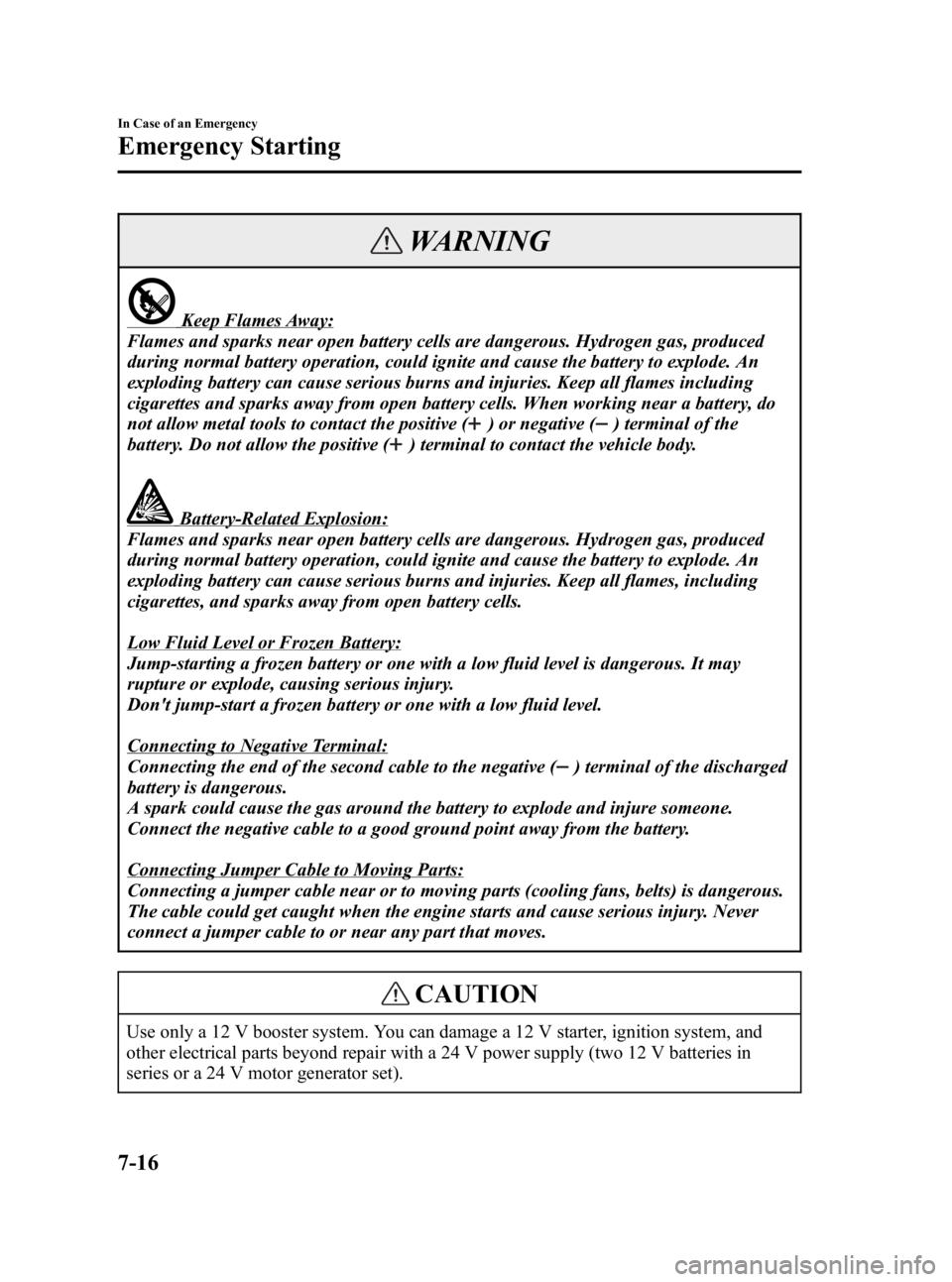
Black plate (236,1)
WARNING
Keep Flames Away:
Flames and sparks near open battery cells are dangerous. Hydrogen gas, produced
during normal battery operation, could ignite and cause the battery to explode. An
exploding battery can cause serious burns and injuries. Keep all flames including
cigarettes and sparks away from open battery cells. When working near a battery, do
not allow metal tools to contact the positive (
) or negative () terminal of the
battery. Do not allow the positive (
) terminal to contact the vehicle body.
Battery-Related Explosion:
Flames and sparks near open battery cells are dangerous. Hydrogen gas, produced
during normal battery operation, could ignite and cause the battery to explode. An
exploding battery can cause serious burns and injuries. Keep all flames, including
cigarettes, and sparks away from open battery cells.
Low Fluid Level or Frozen Battery:
Jump-starting a frozen battery or one with a low fluid level is dangerous. It may
rupture or explode, causing serious injury.
Don't jump-start a frozen battery or one with a low fluid level.
Connecting to Negative Terminal:
Connecting the end of the second cable to the negative (
) terminal of the discharged
battery is dangerous.
A spark could cause the gas around the battery to explode and injure someone.
Connect the negative cable to a good ground point away from the battery.
Connecting Jumper Cable to Moving Parts:
Connecting a jumper cable near or to moving parts (cooling fans, belts) is dangerous.
The cable could get caught when the engine starts and cause serious injury. Never
connect a jumper cable to or near any part that moves.
CAUTION
Use only a 12 V booster system. You can damage a 12 V starter, ignition system, and
other electrical parts beyond repair with a 24 V power supply (two 12 V batteries in
series or a 24 V motor generator set).
7-16
In Case of an Emergency
Emergency Starting
Mazda3_8T96-EA-04J_Edition3 Page236
Wednesday, May 11 2005 3:39 PM
Form No.8T96-EA-04J
Page 237 of 378
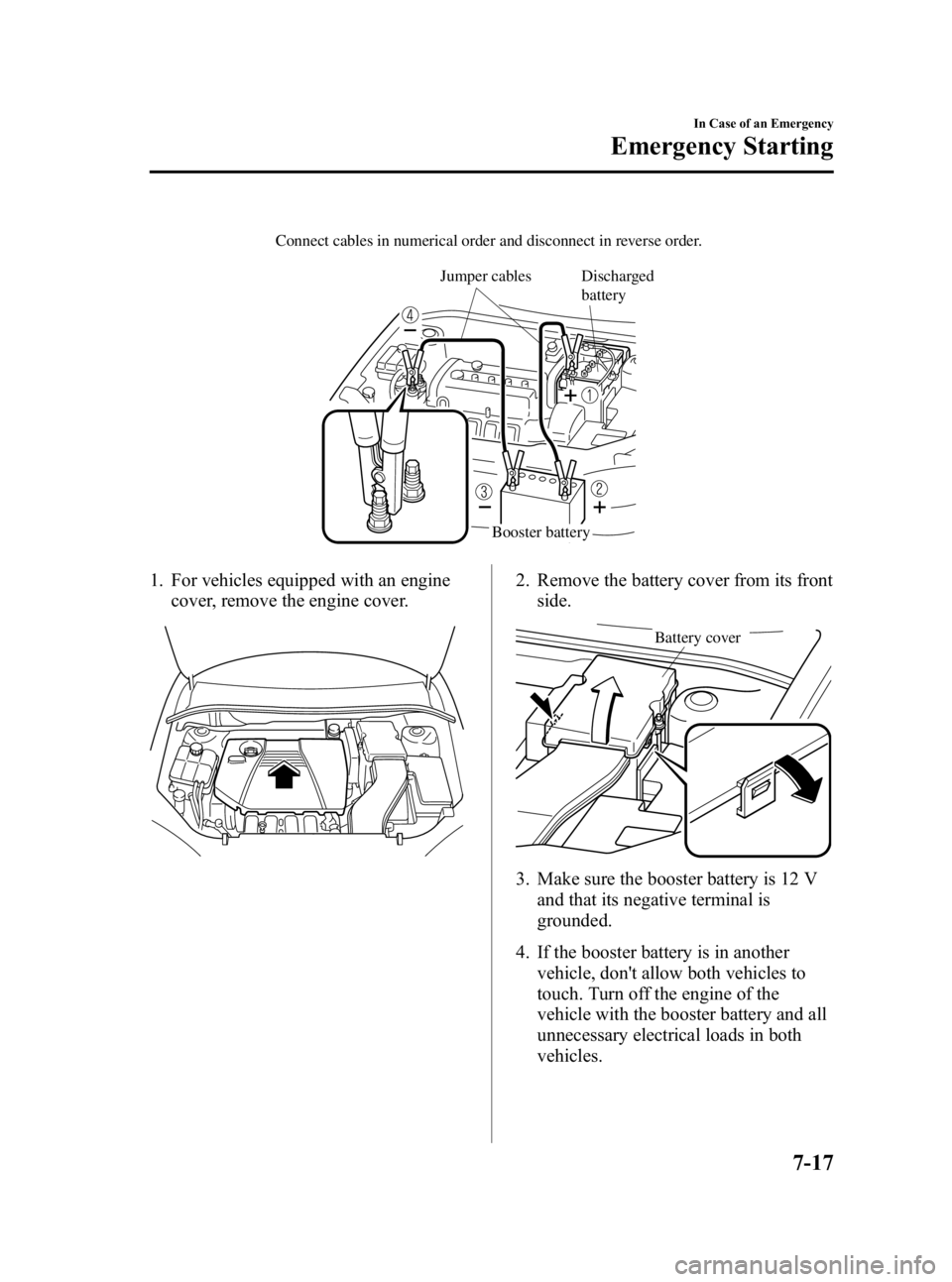
Black plate (237,1)
Connect cables in numerical order and disconnect in reverse order.Jumper cables
Booster battery
Discharged
battery
1. For vehicles equipped with an enginecover, remove the engine cover.2. Remove the battery cover from its frontside.
Battery cover
3. Make sure the booster battery is 12 Vand that its negative terminal is
grounded.
4. If the booster battery is in another vehicle, don't allow both vehicles to
touch. Turn off the engine of the
vehicle with the booster battery and all
unnecessary electrical loads in both
vehicles.
In Case of an Emergency
Emergency Starting
7-17
Mazda3_8T96-EA-04J_Edition3 Page237
Wednesday, May 11 2005 3:39 PM
Form No.8T96-EA-04J
Page 238 of 378
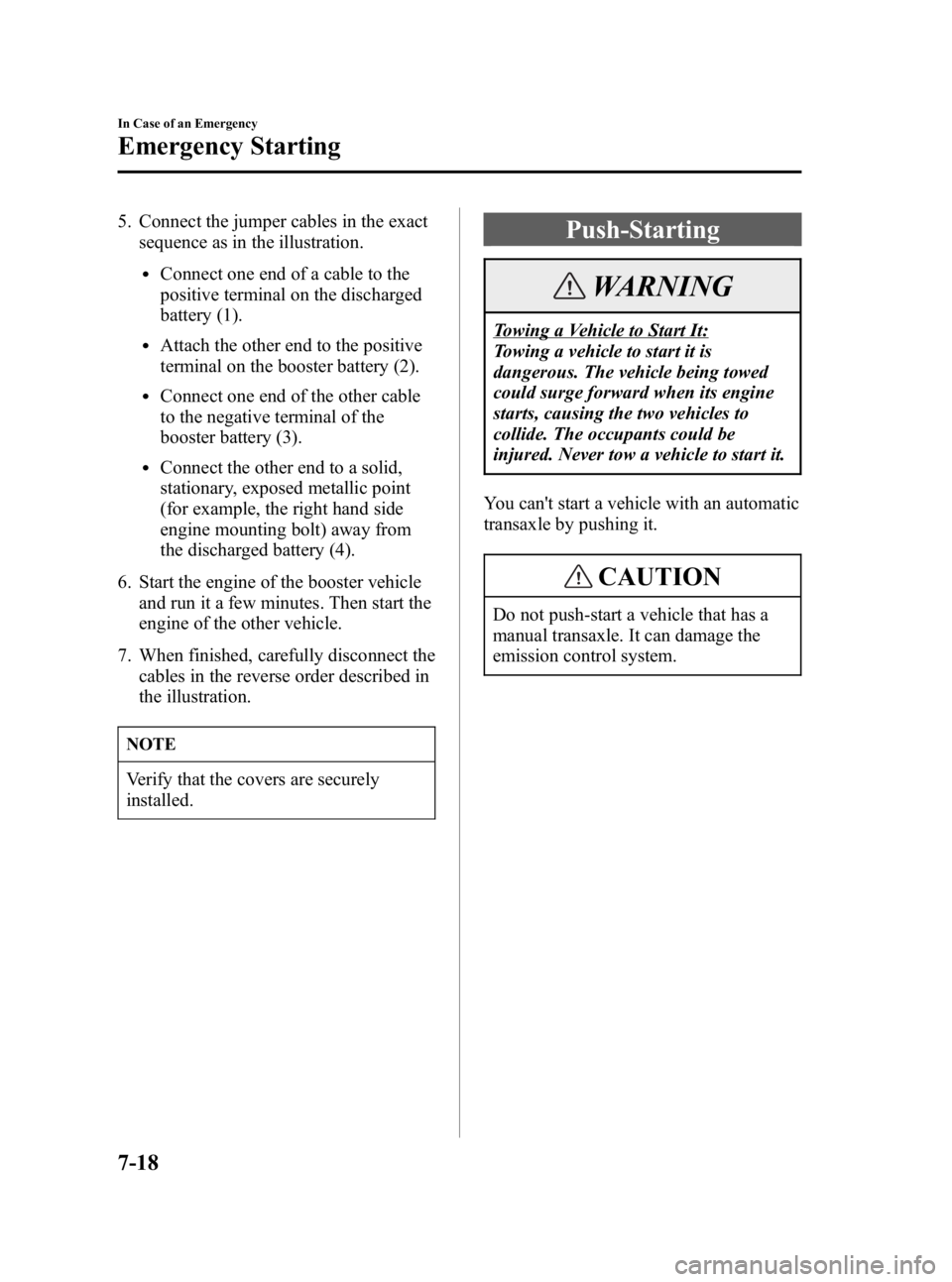
Black plate (238,1)
5. Connect the jumper cables in the exactsequence as in the illustration.
lConnect one end of a cable to the
positive terminal on the discharged
battery (1).
lAttach the other end to the positive
terminal on the booster battery (2).
lConnect one end of the other cable
to the negative terminal of the
booster battery (3).
lConnect the other end to a solid,
stationary, exposed metallic point
(for example, the right hand side
engine mounting bolt) away from
the discharged battery (4).
6. Start the engine of the booster vehicle and run it a few minutes. Then start the
engine of the other vehicle.
7. When finished, carefully disconnect the cables in the reverse order described in
the illustration.
NOTE
Verify that the covers are securely
installed.
Push-Starting
WARNING
Towing a Vehicle to Start It:
Towing a vehicle to start it is
dangerous. The vehicle being towed
could surge forward when its engine
starts, causing the two vehicles to
collide. The occupants could be
injured. Never tow a vehicle to start it.
You can't start a vehicle with an automatic
transaxle by pushing it.
CAUTION
Do not push-start a vehicle that has a
manual transaxle. It can damage the
emission control system.
7-18
In Case of an Emergency
Emergency Starting
Mazda3_8T96-EA-04J_Edition3 Page238
Wednesday, May 11 2005 3:39 PM
Form No.8T96-EA-04J
Page 243 of 378
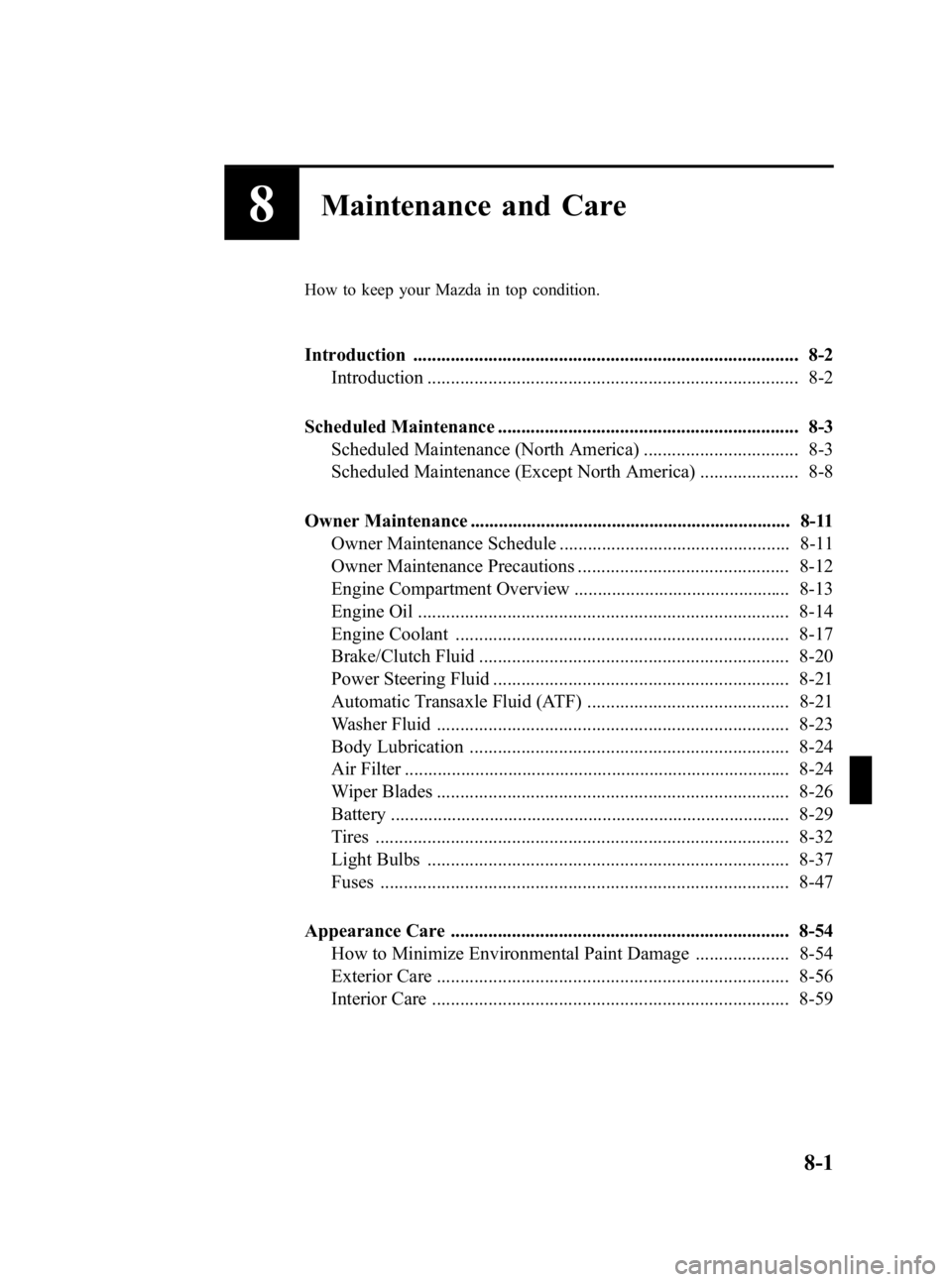
Black plate (243,1)
8Maintenance and Care
How to keep your Mazda in top condition.
Introduction .................................................................................. 8-2Introduction ............................................................................... 8-2
Scheduled Maintenance ................................................................ 8-3 Scheduled Maintenance (North America) ................................. 8-3
Scheduled Maintenance (Except North America) ..................... 8-8
Owner Maintenance .................................................................... 8-11 Owner Maintenance Schedule ................................................. 8-11
Owner Maintenance Precautions ............................................. 8-12
Engine Compartment Overview .............................................. 8-13
Engine Oil ............................................................................... 8-14
Engine Coolant ....................................................................... 8-17
Brake/Clutch Fluid .................................................................. 8-20
Power Steering Fluid ............................................................... 8-21
Automatic Transaxle Fluid (ATF) ........................................... 8-21
Washer Fluid ........................................................................... 8-23
Body Lubrication .................................................................... 8-24
Air Filter .................................................................................. 8-24
Wiper Blades ........................................................................... 8-26
Battery ..................................................................................... 8-29
Tires ........................................................................................ 8-32
Light Bulbs ............................................................................. 8-37
Fuses ....................................................................................... 8-47
Appearance Care ........................................................................ 8-54 How to Minimize Environmental Paint Damage .................... 8-54
Exterior Care ........................................................................... 8-56
Interior Care ............................................................................ 8-59
8-1
Mazda3_8T96-EA-04J_Edition3 Page243
Wednesday, May 11 2005 3:39 PM
Form No.8T96-EA-04J
Page 246 of 378
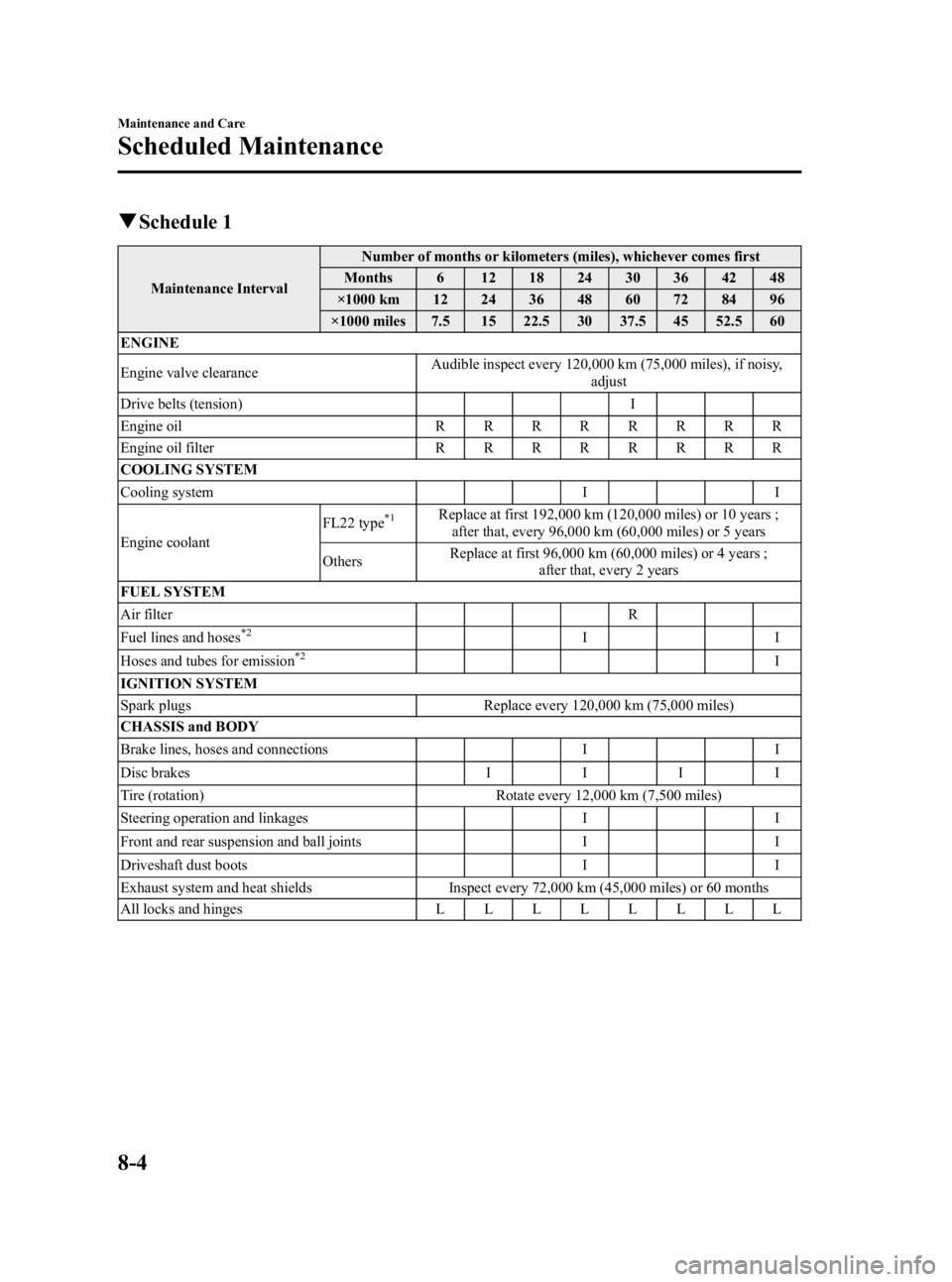
Black plate (246,1)
qSchedule 1
Maintenance Interval Number of months or kilometers (miles), whichever comes first
Months 6 12 18 24 30 36 42 48
×1000 km 12 24 36 48 60 72 84 96
×1000 miles 7.5 15 22.5 30 37.5 45 52.5 60
ENGINE
Engine valve clearance Audible inspect every 120,000 km (75,000 miles), if noisy,
adjust
Drive belts (tension) I
Engine oil RRRRRRRR
Engine oil filter RRRRRRRR
COOLING SYSTEM
Cooling system II
Engine coolant FL22 type
*1Replace at first 192,000 km (120,000 miles) or 10 years ;
after that, every 96,000 km (60,000 miles) or 5 years
Others Replace at first 96,000 km (60,000 miles) or 4 years ;
after that, every 2 years
FUEL SYSTEM
Air filter R
Fuel lines and hoses
*2II
Hoses and tubes for emission*2I
IGNITION SYSTEM
Spark plugs Replace every 120,000 km (75,000 miles)
CHASSIS and BODY
Brake lines, hoses and connections I I
Disc brakes IIII
Tire (rotation) Rotate every 12,000 km (7,500 miles)
Steering operation and linkages I I
Front and rear suspension and ball joints I I
Driveshaft dust boots I I
Exhaust system and heat shields Inspect every 72,000 km (45,000 miles) or 60 months
All locks and hinges LLLLLLLL
8-4
Maintenance and Care
Scheduled Maintenance
Mazda3_8T96-EA-04J_Edition3 Page246
Wednesday, May 11 2005 3:39 PM
Form No.8T96-EA-04J
Page 248 of 378
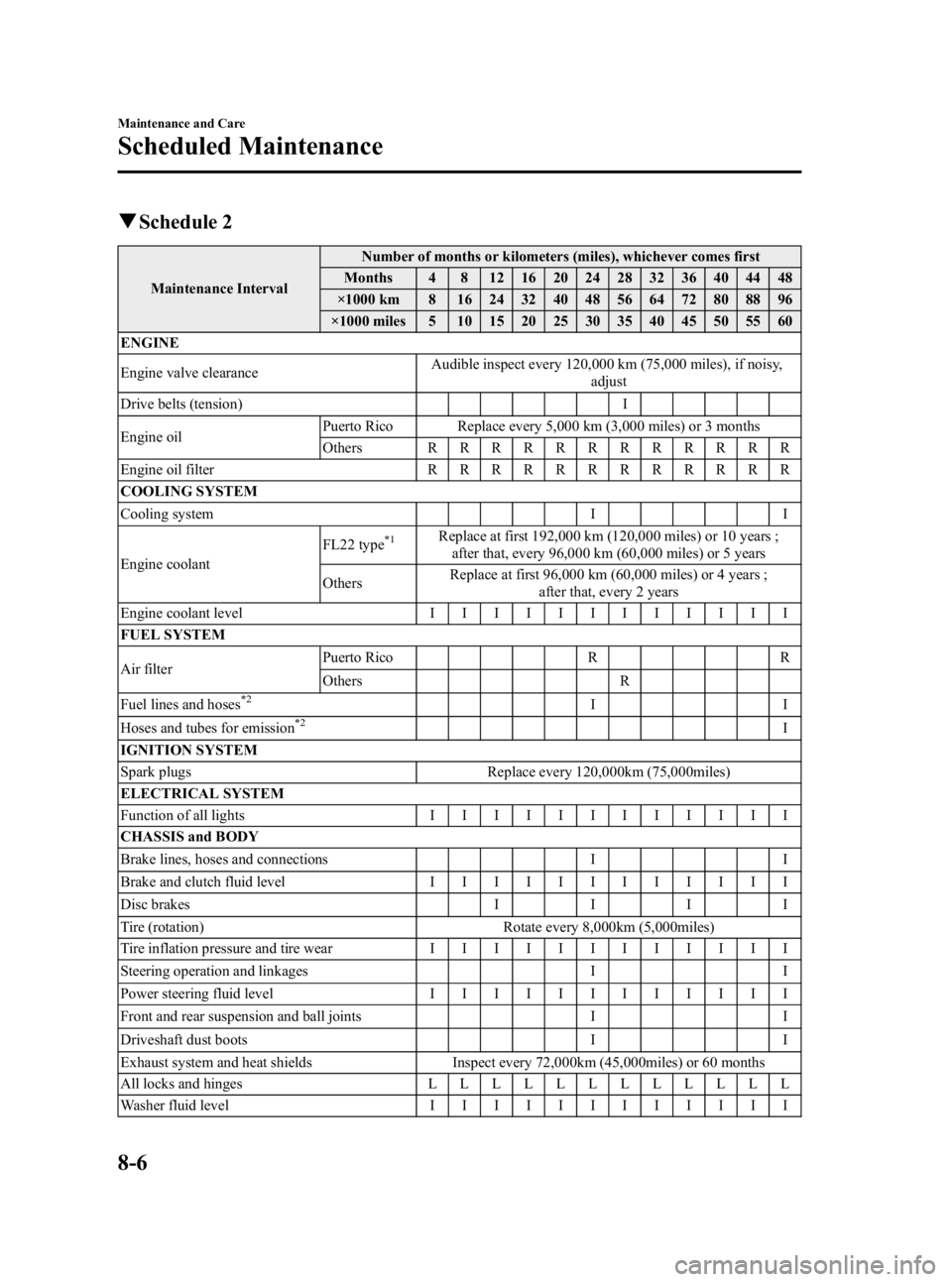
Black plate (248,1)
qSchedule 2
Maintenance Interval Number of months or kilometers (miles), whichever comes first
Months 4 8 12 16 20 24 28 32 36 40 44 48
×1000 km 8 16 24 32 40 48 56 64 72 80 88 96
×1000 miles 5 10 15 20 25 30 35 40 45 50 55 60
ENGINE
Engine valve clearance Audible inspect every 120,000 km (75,000 miles), if noisy,
adjust
Drive belts (tension) I
Engine oil Puerto Rico Replace every 5,000 km (3,000 miles) or 3 months
Others
RRRRRRRRRRRR
Engine oil filter RRRRRRRRRRRR
COOLING SYSTEM
Cooling system II
Engine coolant FL22 type
*1Replace at first 192,000 km (120,000 miles) or 10 years ;
after that, every 96,000 km (60,000 miles) or 5 years
Others Replace at first 96,000 km (60,000 miles) or 4 years ;
after that, every 2 years
Engine coolant level IIIIIIIIIIII
FUEL SYSTEM
Air filter Puerto Rico R R
Others R
Fuel lines and hoses
*2II
Hoses and tubes for emission*2I
IGNITION SYSTEM
Spark plugs Replace every 120,000km (75,000miles)
ELECTRICAL SYSTEM
Function of all lights IIIIIIIIIIII
CHASSIS and BODY
Brake lines, hoses and connections I I
Brake and clutch fluid level IIIIIIIIIIII
Disc brakes IIII
Tire (rotation) Rotate every 8,000km (5,000miles)
Tire inflation pressure and tire wear IIIIIIIIIIII
Steering operation and linkages I I
Power steering fluid level IIIIIIIIIIII
Front and rear suspension and ball joints I I
Driveshaft dust boots I I
Exhaust system and heat shields Inspect every 72,000km (45,000miles) or 60 months
All locks and hinges LLLLLLLLLLLL
Washer fluid level IIIIIIIIIIII
8-6
Maintenance and Care
Scheduled Maintenance
Mazda3_8T96-EA-04J_Edition3 Page248
Wednesday, May 11 2005 3:39 PM
Form No.8T96-EA-04J
Page 250 of 378
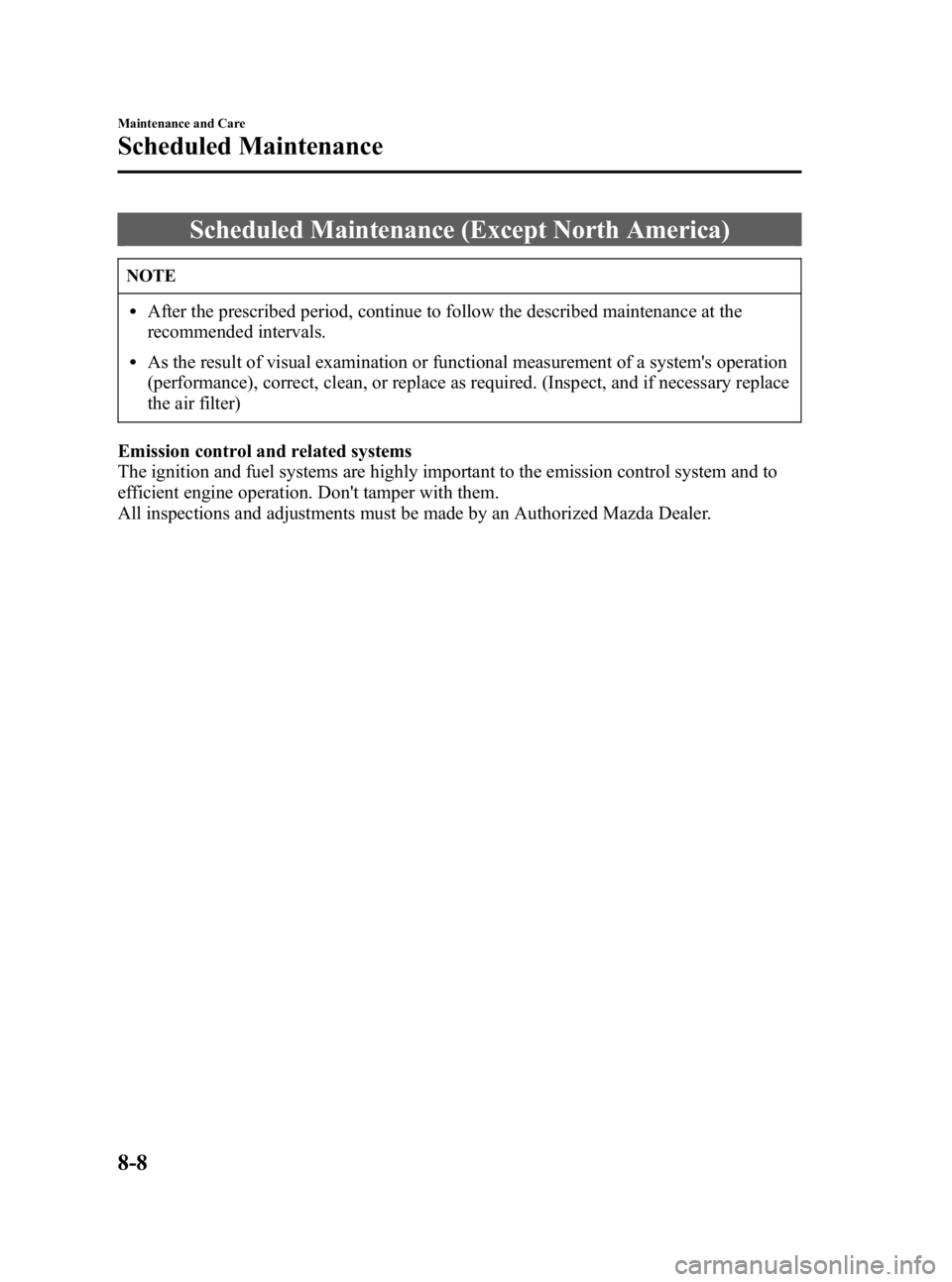
Black plate (250,1)
Scheduled Maintenance (Except North America)
NOTE
lAfter the prescribed period, continue to follow the described maintenance at the
recommended intervals.
lAs the result of visual examination or functional measurement of a system's operation
(performance), correct, clean, or replace as required. (Inspect, and if necessary replace
the air filter)
Emission control and related systems
The ignition and fuel systems are highly important to the emission control system and to
efficient engine operation. Don't tamper with them.
All inspections and adjustments must be made by an Authorized Mazda Dealer.
8-8
Maintenance and Care
Scheduled Maintenance
Mazda3_8T96-EA-04J_Edition3 Page250
Wednesday, May 11 2005 3:39 PM
Form No.8T96-EA-04J
Page 251 of 378
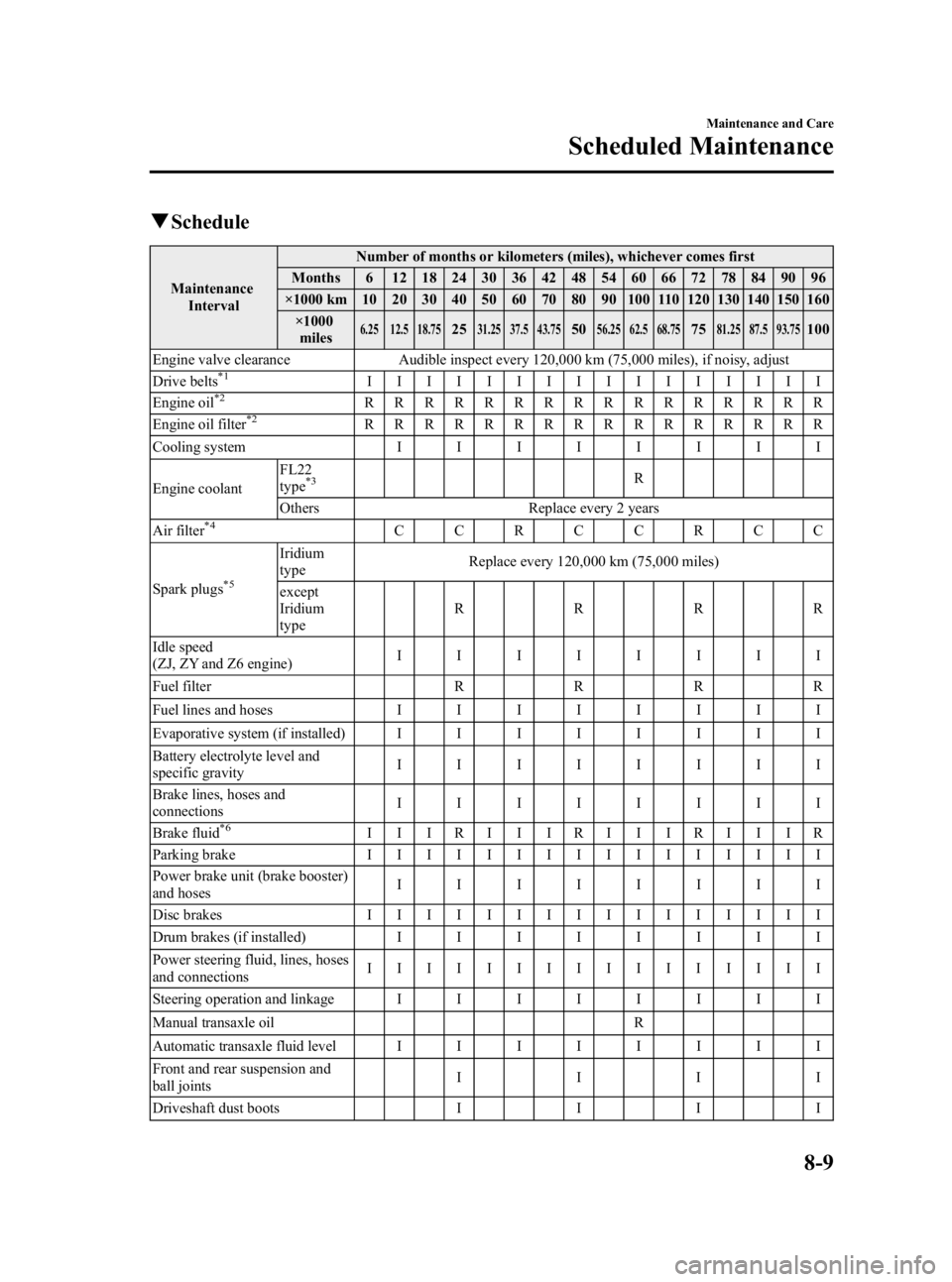
Black plate (251,1)
qSchedule
Maintenance
Interval Number of months or kilometers (miles), whichever comes first
Months 6 12 18 24 30 36 42 48 54 60 66 72 78 84 90 96
×1000 km 10 20 30 40 50 60 70 80 90 100 110 120 130 140 150 160 ×1000miles
6.25 12.5 18.752531.25 37.5 43.755056.25 62.5 68.757581.25 87.5 93.75100
Engine valve clearance Audible inspect every 120,000 km (75,000 miles), if noisy, adjust
Drive belts
*1IIIIIIIIIIIIIIII
Engine oil*2RRRRRRRRRRRRRRRR
Engine oil filter*2RRRRRRRRRRRRRRRR
Cooling system IIIIIIII
Engine coolant FL22
type
*3R
Others Replace every 2 years
Air filter
*4CCRCCRCC
Spark plugs
*5
Iridium
type Replace every 120,000 km (75,000 miles)
except
Iridium
type RRRR
Idle speed
(ZJ, ZY and Z6 engine) IIIIIIII
Fuel filter RRRR
Fuel lines and hoses IIIIIIII
Evaporative system (if installed) IIIIIIII
Battery electrolyte level and
specific gravity IIIIIIII
Brake lines, hoses and
connections IIIIIIII
Brake fluid
*6IIIRIIIRIIIRIIIR
Parking brake IIIIIIIIIIIIIIII
Power brake unit (brake booster)
and hoses IIIIIIII
Disc brakes IIIIIIIIIIIIIIII
Drum brakes (if installed) IIIIIIII
Power steering fluid, lines, hoses
and connections IIIIIIIIIIIIIIII
Steering operation and linkage IIIIIIII
Manual transaxle oil R
Automatic transaxle fluid level IIIIIIII
Front and rear suspension and
ball joints IIII
Driveshaft dust boots IIII
Maintenance and Care
Scheduled Maintenance
8-9
Mazda3_8T96-EA-04J_Edition3 Page251
Wednesday, May 11 2005 3:39 PM
Form No.8T96-EA-04J
Page 252 of 378
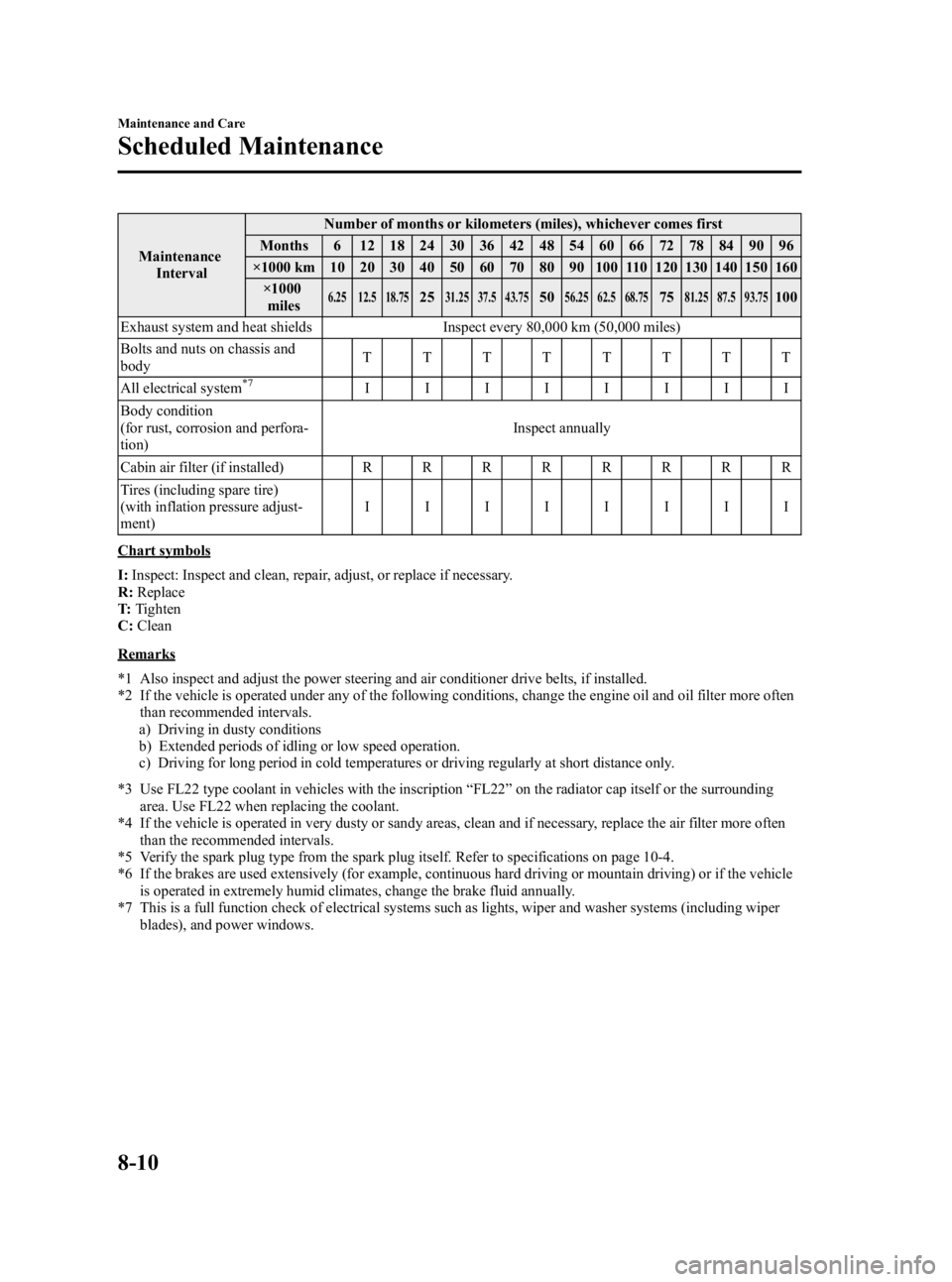
Black plate (252,1)
MaintenanceInterval Number of months or kilometers (miles), whichever comes first
Months 6 12 18 24 30 36 42 48 54 60 66 72 78 84 90 96
×1000 km 10 20 30 40 50 60 70 80 90 100 110 120 130 140 150 160 ×1000miles
6.25 12.5 18.752531.25 37.5 43.755056.25 62.5 68.757581.25 87.5 93.75100
Exhaust system and heat shields Inspect every 80,000 km (50,000 miles)
Bolts and nuts on chassis and
body TTTTTTTT
All electrical system
*7IIIIIIII
Body condition
(for rust, corrosion and perfora-
tion) Inspect annually
Cabin air filter (if installed) RRRRRRRR
Tires (including spare tire)
(with inflation pressure adjust-
ment) IIIIIIII
Chart symbols
I:
Inspect: Inspect and clean, repair, adjust, or replace if necessary.
R: Replace
T: Tighten
C: Clean
Remarks
*1 Also inspect and adjust the power steering and air conditioner drive belts, if installed.
*2 If the vehicle is operated under any of the following conditions, change the engine oil and oil filter more often
than recommended intervals.
a) Driving in dusty conditions
b) Extended periods of idling or low speed operation.
c) Driving for long period in cold temperatures or driving regularly at short distance only.
*3 Use FL22 type coolant in vehicles with the inscription “FL22 ”on the radiator cap itself or the surrounding
area. Use FL22 when replacing the coolant.
*4 If the vehicle is operated in very dusty or sandy areas, clean and if necessary, replace the air filter more often than the recommended intervals.
*5 Verify the spark plug type from the spark plug itself. Refer to specifications on page 10-4.
*6 If the brakes are used extensively (for example, continuous hard driving or mountain driving) or if the vehicle is operated in extremely humid climates, change the brake fluid annually.
*7 This is a full function check of electrical systems such as lights, wiper and washer systems (including wiper blades), and power windows.
8-10
Maintenance and Care
Scheduled Maintenance
Mazda3_8T96-EA-04J_Edition3 Page252
Wednesday, May 11 2005 3:39 PM
Form No.8T96-EA-04J